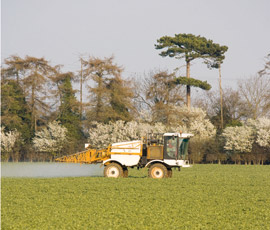Mitigating the effects of loss of crop vigour

Oilseed rape sickness is widely known and research shows it can reduce yields by 12% in very tight rotations, but there are still a number of measures growers can take to help mitigate this reduction in vigour.
HGCA-funded research carried out by NIAB TAG’s Ron Stobart at Morley in Norfolk looked at the effect of rotation on yields ranging from cropping virgin oilseed rape land, continuous, alternating with winter wheat, and increasing length of rotation up to six years. There was a clear reduction in yield in shorter rotations: 3% lower for a three-year gap, 6% for a two-year gap and 12% for alternate wheat/rape compared with a virgin crop.
“Farmers need to take these differences into account, but should be considered relative to other break crop options, and the price achievable for wheat and rape,” explains Mr Stobart. “The financial significance is open to interpretation on individual farms.”
Although the study lasted for eight years, Mr Stobart is conscious that what happens in the years ahead is unknown. Do yields continue to get worse?
The sickness is blamed on a number of factors with volunteers causing management problems such as varietal dilution, competition for resources and opportunities for disease. But it is the discovery in these short rotations of two rooting pathogens, known to be commercially important in other crops, Olpidium brassicae and Pyrenochaeta species, that prompted researchers to investigate their possible role.
“We can’t say with certainty that they are responsible, but we have our suspicions. Work suggests they are having an effect on rooting and on how the above ground parts of the crop perform, he explains.
If these pathogens are in part responsible it might account for the reduced crop vigour in the shorter rotations and the constraints in rooting seen in the trial.
There is also an effect of closer rotations on branching and flowering, with some evidence of the latter being pushed back, he explains. “We have got a handle on what we are losing in close crop rotations; now we are looking at what is driving this.”
Wider issues
ADAS’s Peter Gladders believes there is a wider issue of yield plateau that doesn’t relate entirely to the decline, but encompasses the whole physiological story about yield. He believes one key practice is actually counteracting the low vigour.
“There has been a revolution in the past five years with the move to subsoiler methods of establishment which minimises moisture loss and encourages a good deep tap root.”
Combined with early drilling, ensuring crops are up before the end of August mitigates the effects of soil pathogens including verticillium wilt, which are likely to be more damaging on weak plants and poor root systems, he adds.
Hutchinson’s Dick Neale acknowledges that yield decline is present, but believes growers could do more by applying basic principles to oilseed rape agronomy to improve yields, despite these underlying soil pathogen issues.
“Getting nitrogen incorrect and not applying the correct fungicide mix at the correct time can impact far more on yield than the underlying problem of oilseed rape yield decline.”
Getting nitrogen timing and quantity is crucial to get the balance between the growth they have and the growth they need. This stems around knowing the green area index and soil mineral nitrogen. “We want to get crops to the same stage mid-flower. So knowing soil mineral nitrogen is very important for all crops across the board. This year we have much less cover going into the winter, so we have to manage individual fields.”
Mr Neale also emphasises the importance of autumn and early spring fungicides which play a much more important role than just disease control by influencing the rooting and the winter survival of the overall crop.
“Although growers try to apply fungicide correctly according to forecasts, if a grower has small plants going into October we will advise a fungicide to give the plant a boost to give it the best possible chance of surviving the winter.”
The same applies for stem extension and sclerotinia sprays. It is far more important at stem extension to control light leaf spot well, which seems to be an increasing problem across the country in February, and then apply growth regulation products at green bud to control the branching of the plant and upper canopy structure and there are a number of products growers could use, he says.
Other yield nibblers growers should be on the lookout for include clubroot, which if introduced to a farm will be exacerbated by close rotations and verticillium wilt, the spores from which are transported within seed from farm to farm in fine dust particles.
Opiduim and Pyrenochaeta
Olpidium brassicae and Pyrenochaeta species are soil-borne pathogens not previously associated with oilseed rape disease and although not proven to be the causes of yield decline are found to increase in shorter rotations.
Olpidium brassiciae specifically infects brassica plants and has been identified at oilseed rape field sites across the country. According to Sally Hilton, researcher at Warwick University, Olpidium has been shown to decrease yields in glasshouse studies.
“Pyrenochaeta is less well understood. It is a soil-borne fungus which has also been found on grass and tree roots. Glasshouse studies show that it causes root lesions on oilseed rape, but in the field we need to see how it interacts with other pathogens in the soil,” she says.
Both infect at the seedling stage and Dr Hilton believes there will be specific fungicides that will control these pathogens if required, with breeding for resistant lines also a possibility.

